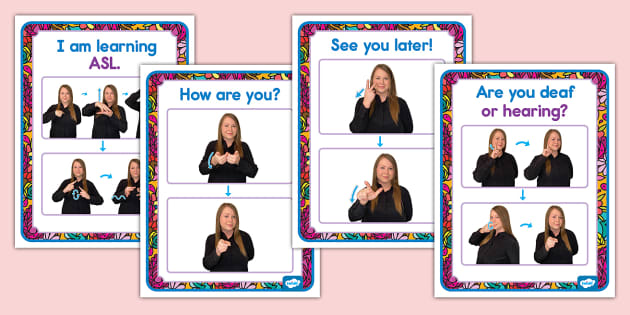Have you ever found yourself in a conversation where words just weren't enough? Maybe you were at a noisy party, or perhaps you were trying to communicate with someone who is deaf or hard of hearing. Whatever the situation, knowing some American Sign Language (ASL) can make your interactions smoother and more inclusive. In this article, we’re diving into essential ASL signs for daily communication—think of it as your handy guide to connecting with family, friends, and even strangers in a fun and engaging way.

With simple ASL signs for practical phrases, you’ll be ready to greet, ask, and express yourself effortlessly. So, whether you're a newbie or looking to brush up on your skills, let’s get signing!
Common Greetings in ASL
First things first—let’s tackle the ASL signs for common greetings. These are the bread and butter of everyday interactions and are super easy to learn!
Key Signs to Remember:
- Hello: Simply wave your hand in front of your face.
- Goodbye: A simple wave will do the trick—just like saying farewell in person!
- How are you?: Hold your dominant hand in front of your chest, then move it away from you, palm facing up.
Using these signs not only helps in communication but also shows respect and inclusivity, which is always a win. For example, at a recent family gathering, my cousin used these signs to greet our deaf uncle, who lit up with joy. It was a beautiful moment that highlighted the power of understanding.
Fun Fact:
According to the National Association of the Deaf, learning basic ASL can help bridge communication gaps, fostering better relationships. So, why not start with these simple greetings?

Daily Conversations Made Easy
Now that you’ve got greetings down, let’s explore how to learn ASL signs for daily conversations. These signs will help you navigate everything from small talk to more meaningful discussions.
Essential Signs:
- Please: Place your dominant hand on your chest and move it in a circular motion.
- Thank you: Start with your fingertips on your chin and move your hand outward, away from your face.
- Yes/No: For “yes,” make a fist and nod; for “no,” shake your head and use an open hand.
Imagine walking into a coffee shop and being able to thank the barista with a smile and a sign. It’s a small gesture, but it makes a big impact! In fact, a study by Gallaudet University found that using ASL in daily interactions can increase social connections and foster community.
Tip:
Practice these signs in front of a mirror or with a friend to boost your confidence. The more you practice, the more natural it will become!

Everyday Expressions for Connection
Everyday expressions are like the seasoning in your communication—they add flavor and personality! Let’s look at some ASL signs for everyday expressions that can enhance your conversations.
Must-Know Expressions:
- I’m sorry: Place your fist on your chest and move it in a circular motion.
- Excuse me: Use your dominant hand to tap the opposite shoulder lightly.
- I love you: Raise your pinky finger, index finger, and thumb while keeping your other fingers folded down.
These signs aren’t just useful; they’re also a way to express empathy and warmth. For instance, when I accidentally bumped into someone at the store, using the sign for “I’m sorry” helped diffuse the situation immediately, turning an awkward moment into a friendly exchange.
Statistic Alert:
Research shows that using expressions in ASL can significantly enhance emotional connections. When you show that you care through simple signs, it can lead to more meaningful interactions!
Family and Friends Interactions
Family dynamics can be complex, but knowing some ASL signs for family and friends interactions can simplify communication and strengthen bonds.
Key Family Signs:
- Family: Bring your hands together in a circular motion to represent unity.
- Friend: Cross your middle fingers, then bring them together.
- Mother/Father: For "mother," place your hand on your chin; for "father," place it on your forehead.
Picture this: You’re at a family reunion, and everyone is mingling. Using ASL signs for family members can spark conversations and help everyone feel included, especially those who are deaf or hard of hearing. For example, when I introduced my cousin using the sign for “family,” it opened up a dialogue that made everyone feel connected.
Pro Tip:
Incorporate these signs into family gatherings or game nights to make learning fun! It’s not just about communication; it’s about building relationships.
Conclusion: Get Started with ASL Today!
Now that you’re equipped with essential ASL signs for daily communication, it’s time to put your knowledge into practice! Whether you’re using ASL signs for common greetings or learning ASL signs for daily conversations, every little bit counts in creating a more inclusive environment.
Remember, the beauty of learning ASL lies not just in the signs themselves, but in the connections they help you forge. So, gather your family and friends, practice together, and watch as you all become more adept at communicating with everyone around you.
Ready to dive in? Start today, and you’ll be amazed at how quickly you can learn ASL signs for everyday expressions and interactions! Happy signing!